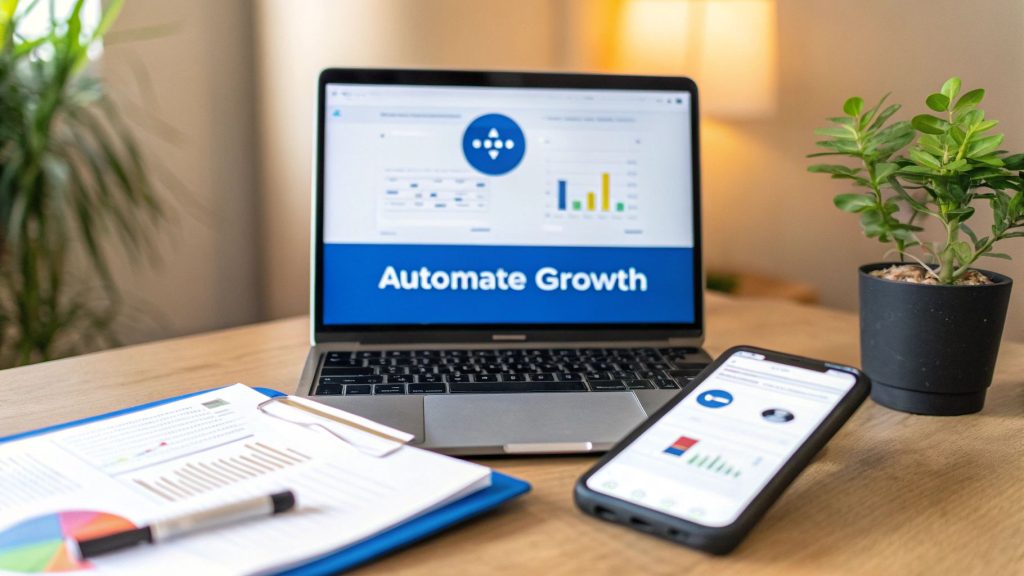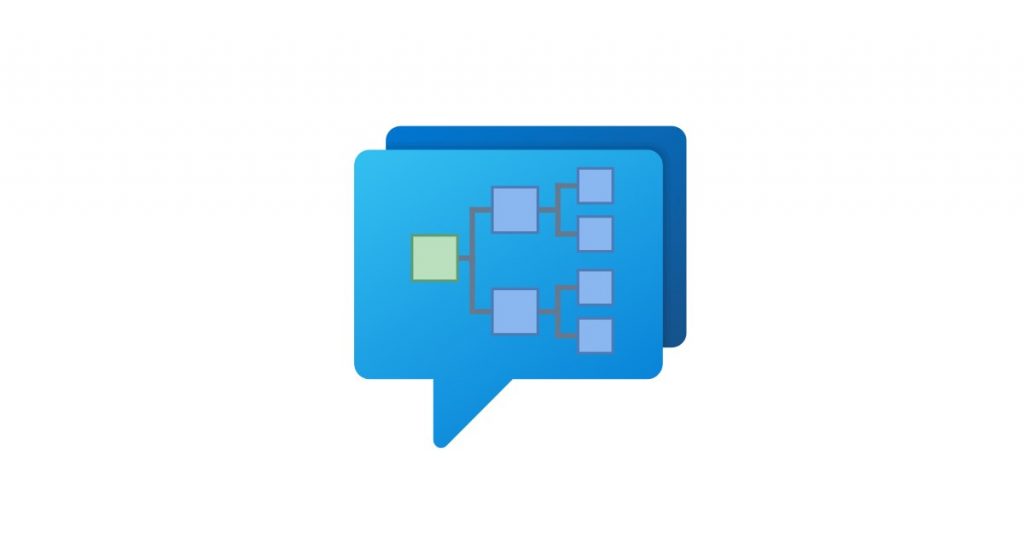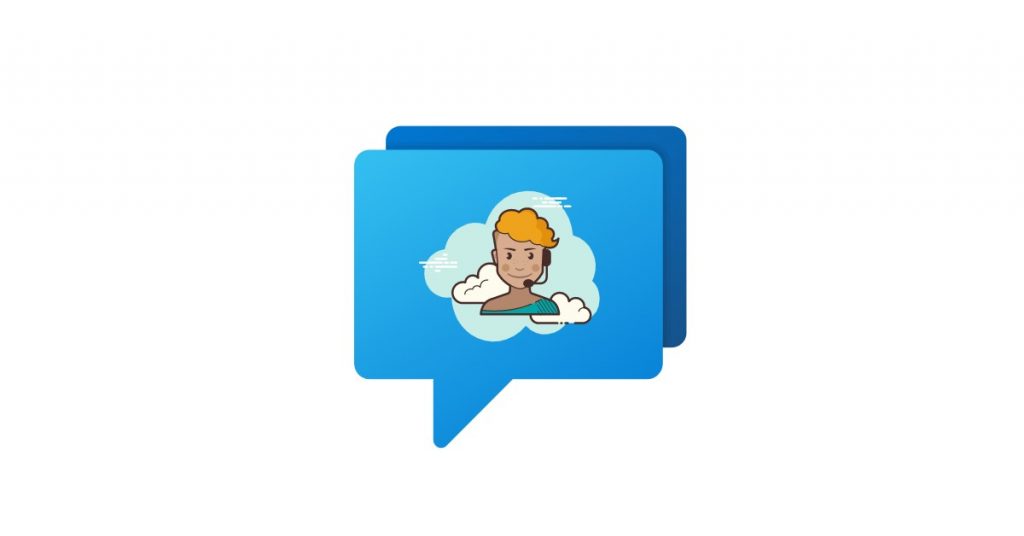Supercharge Your Marketing with Automation in 2025
Want to boost engagement, qualify leads faster, and drive more sales? Marketing automation is the key. This listicle delivers 10 actionable strategies to revamp your marketing approach for 2025, incorporating AI-powered tools and chatbot integrations for platforms like Microsoft Teams, Google Chat, Slack, Zoom, and Webex. These strategies cover everything from refining lead nurturing to optimizing customer retention and lifecycle marketing.
We’ll dive into specific tactics you can implement today. You’ll learn how to:
- Personalize your messaging with dynamic content
- Orchestrate multi-channel marketing campaigns seamlessly
- Harness predictive analytics for smarter automation
- Leverage the power of Account-Based Marketing (ABM)
- Supercharge your social media marketing with automation
- And much more!
Effective marketing automation is no longer optional, it’s essential for staying competitive. These strategies will help you work smarter, not harder, by streamlining your workflows and maximizing your ROI. For staying current with marketing automation trends, consider following a relevant industry blog like the connectflux blog from ConnectFlux – Done For You Outreach Services. We’ll explore practical implementation details, real-world examples, and innovative approaches to common marketing challenges. Let’s dive in.
1. Lead Scoring and Nurturing
Lead scoring and nurturing is a crucial marketing automation strategy that helps businesses prioritize leads, personalize communication, and improve conversion rates. This approach ranks prospects based on their behavior, demographics, and engagement, allowing sales teams to focus on the most promising opportunities. By assigning point values to actions like website visits, content downloads, and email opens, businesses can identify leads nearing the buying stage. This automated process triggers tailored nurturing campaigns, delivering the right information at the right time.

To effectively supercharge your marketing in 2025, consider leveraging proven marketing automation strategies to streamline these efforts. Platforms like HubSpot, Marketo, and Salesforce Pardot offer robust lead scoring capabilities. For example, HubSpot tracks website visits, email interactions, and content downloads, while Marketo excels in behavioral scoring for B2B companies by monitoring demo requests and pricing page views. Salesforce Pardot focuses on demographics like job title and company size, combined with engagement level.
Implementing Effective Lead Scoring
- Start simple: Begin with a basic scoring model, focusing on key actions. Gradually add complexity as you gather more data.
- Regular review: Analyze your scoring thresholds regularly with input from the sales team to ensure alignment with actual lead quality.
- Combine scoring types: Use both implicit (behavioral) and explicit (demographic) scoring to create a holistic view of each lead.
- Negative scoring: Deduct points for undesirable actions, such as unsubscribing from emails or visiting job posting pages.
- Persona-based models: Develop different scoring models for different buyer personas to tailor the nurturing experience.
Lead scoring and nurturing not only improves sales efficiency but also enhances the customer experience by providing personalized and relevant content. Learn more about lead scoring and nurturing and how it can be implemented within your existing lead qualification process. This powerful marketing automation strategy ensures that no promising lead falls through the cracks, maximizing your return on marketing investment.
2. Drip Email Campaigns
Drip email campaigns are a powerful marketing automation strategy involving pre-written email series automatically sent to subscribers over a specific timeframe. These campaigns are triggered by actions like sign-ups, purchases, or specific behaviors. They nurture relationships by delivering relevant content at strategic intervals, guiding prospects through the customer journey toward conversion. This automated approach allows businesses to maintain consistent communication and build stronger connections with their audience.
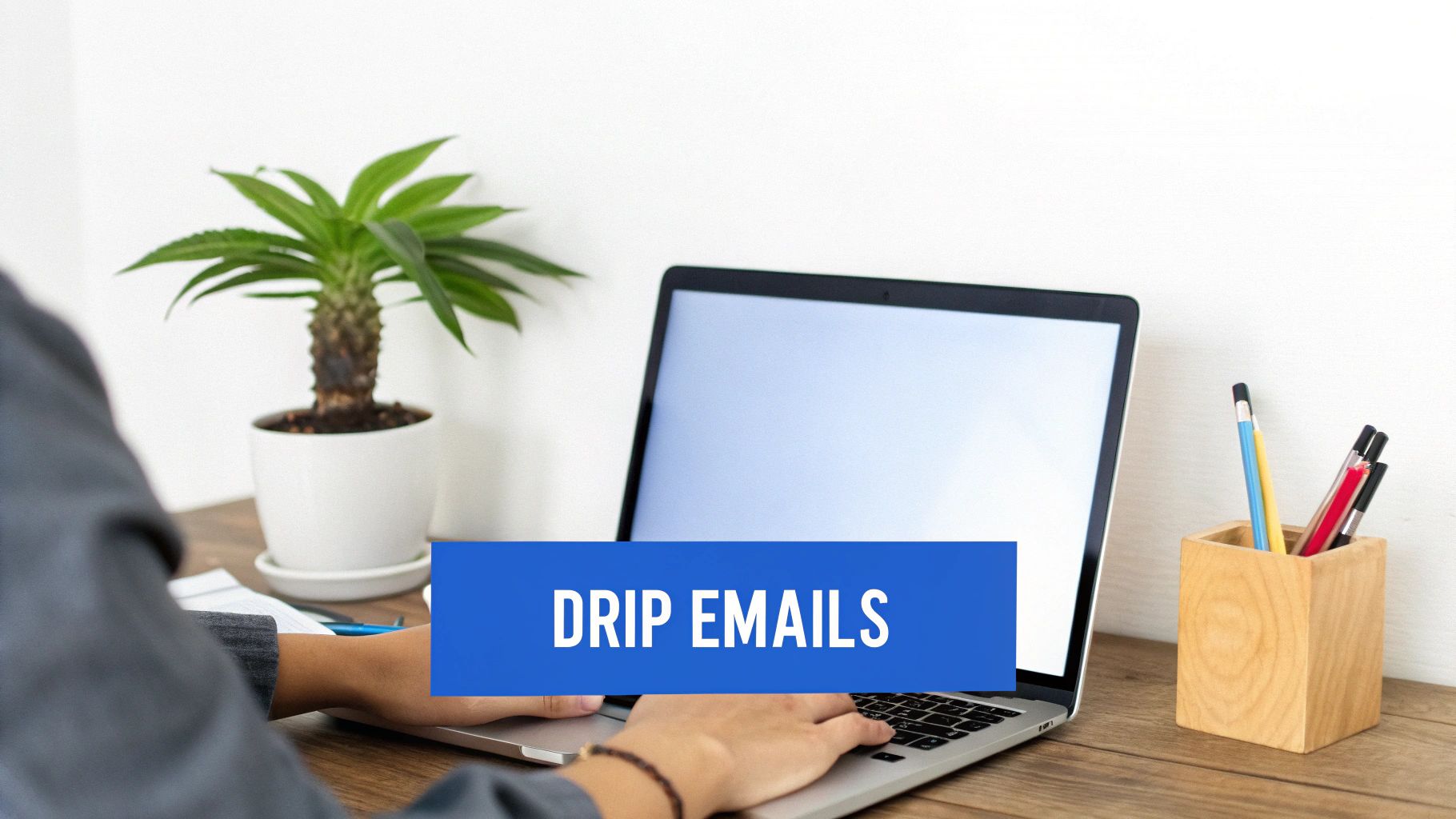
Successful examples include Airbnb’s welcome series educating new hosts, Dropbox’s onboarding sequence guiding users through features, and Spotify’s re-engagement campaigns for inactive users with personalized playlists. These demonstrate the versatility of drip campaigns for various marketing goals. Leveraging these campaigns as part of your marketing automation strategies can significantly improve customer engagement and drive conversions. Platforms like Mailchimp, ConvertKit, and ActiveCampaign offer robust features for designing and automating these email sequences.
Implementing Effective Drip Campaigns
- Map content to the buyer’s journey: Tailor email content to specific stages, from awareness to decision.
- Use behavioral triggers: Trigger emails based on user actions for a more personalized experience. Don’t rely solely on time-based sequences.
- Clear calls-to-action: Include compelling CTAs in every email to guide recipients towards desired actions.
- Test and optimize: Experiment with send times and frequencies to maximize open and click-through rates.
- Maintain list health: Provide easy unsubscribe options to respect subscriber preferences.
Drip campaigns enhance the customer experience by providing timely and relevant information, ultimately boosting conversion rates. By automating this process, businesses can efficiently nurture leads and build lasting relationships with their audience, maximizing the impact of their marketing efforts. This is a key component of effective marketing automation strategies for 2025 and beyond.
3. Behavioral Triggered Campaigns
Behavioral triggered campaigns are a powerful marketing automation strategy that responds directly to customer actions. These campaigns activate based on specific behaviors like website visits, email clicks, or adding items to a cart. This allows businesses to deliver timely and relevant messages, increasing engagement and conversions. Examples include Amazon’s product recommendations based on browsing history and Netflix’s viewing suggestions.
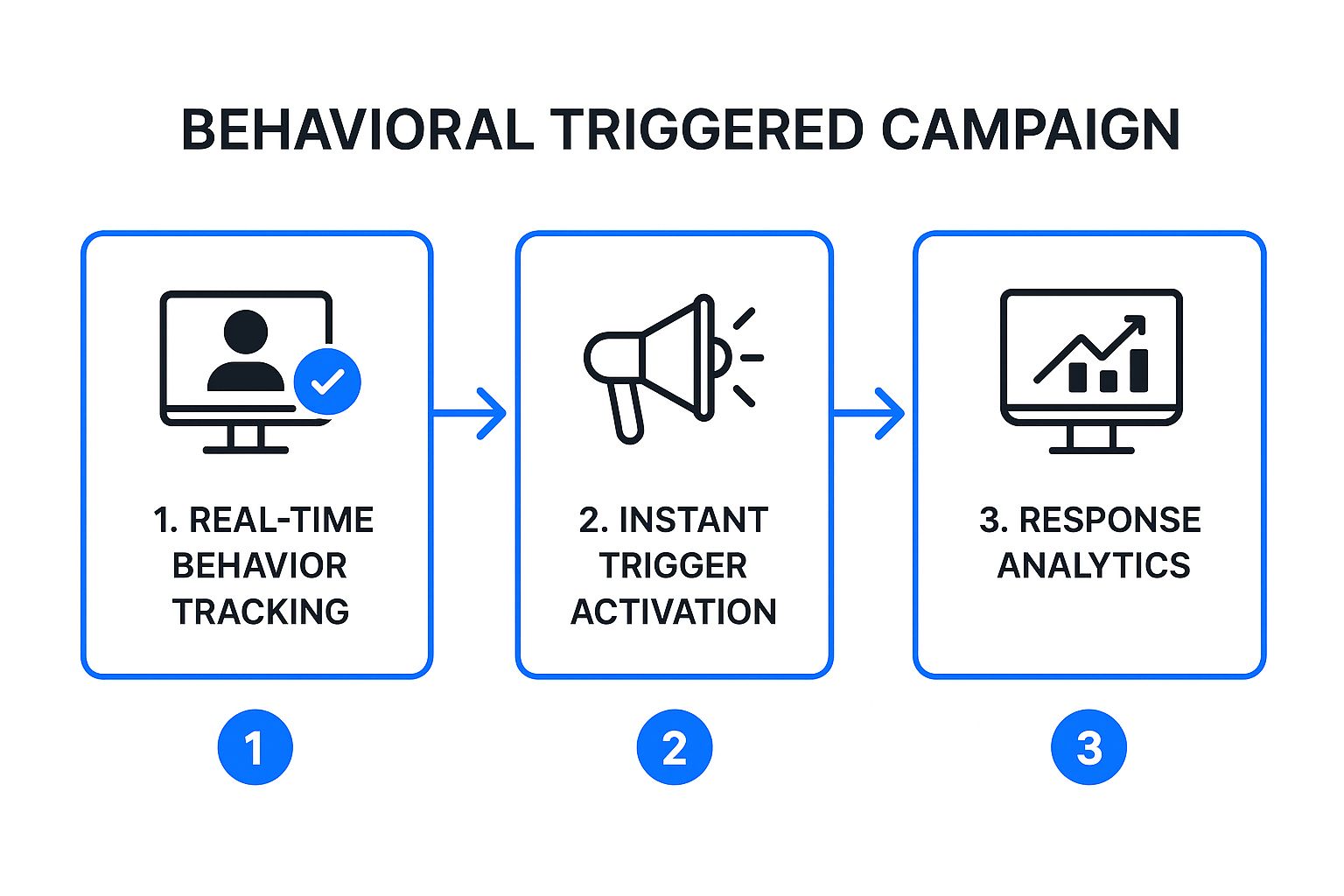
The infographic illustrates the three-step workflow of a behavioral triggered campaign: real-time behavior tracking, instant trigger activation, and response analytics. This visualized process highlights how user actions initiate automated responses and how data is collected to optimize future campaigns.
To effectively leverage behavioral triggered campaigns as part of your marketing automation strategies, consider using platforms like Klaviyo and Segment. These platforms specialize in tracking user behavior and automating personalized messages. For example, Klaviyo allows for precise email automation based on purchase history, while Segment helps consolidate customer data from various sources.
Implementing Effective Behavioral Triggers
- Set appropriate thresholds: Avoid overwhelming users with excessive notifications. Define clear trigger points that align with genuine interest.
- Tailor message templates: Craft behavior-specific messages that resonate with the user’s actions. Personalization is key.
- Frequency capping: Implement limits to prevent message fatigue. Find the balance between engagement and overexposure.
- Progressive profiling: Enhance behavioral data by gradually gathering more information about users.
- Test trigger timing: Experiment with different timings to optimize response rates.
Behavioral triggered campaigns not only boost engagement but also strengthen customer relationships through personalized interactions. This proactive approach provides value by offering relevant content at precisely the right moment, ultimately driving conversions and increasing revenue.
4. Customer Journey Mapping and Automation
Customer journey mapping and automation is a powerful marketing automation strategy that visually outlines every touchpoint a customer has with your brand, from initial awareness to becoming a loyal advocate. By understanding this journey, businesses can automate personalized communications and experiences at each stage, fostering deeper engagement and boosting conversions. This approach ensures consistent and relevant interactions, strengthening customer relationships and driving business growth. Effective customer journey mapping empowers businesses to anticipate customer needs and proactively deliver value.
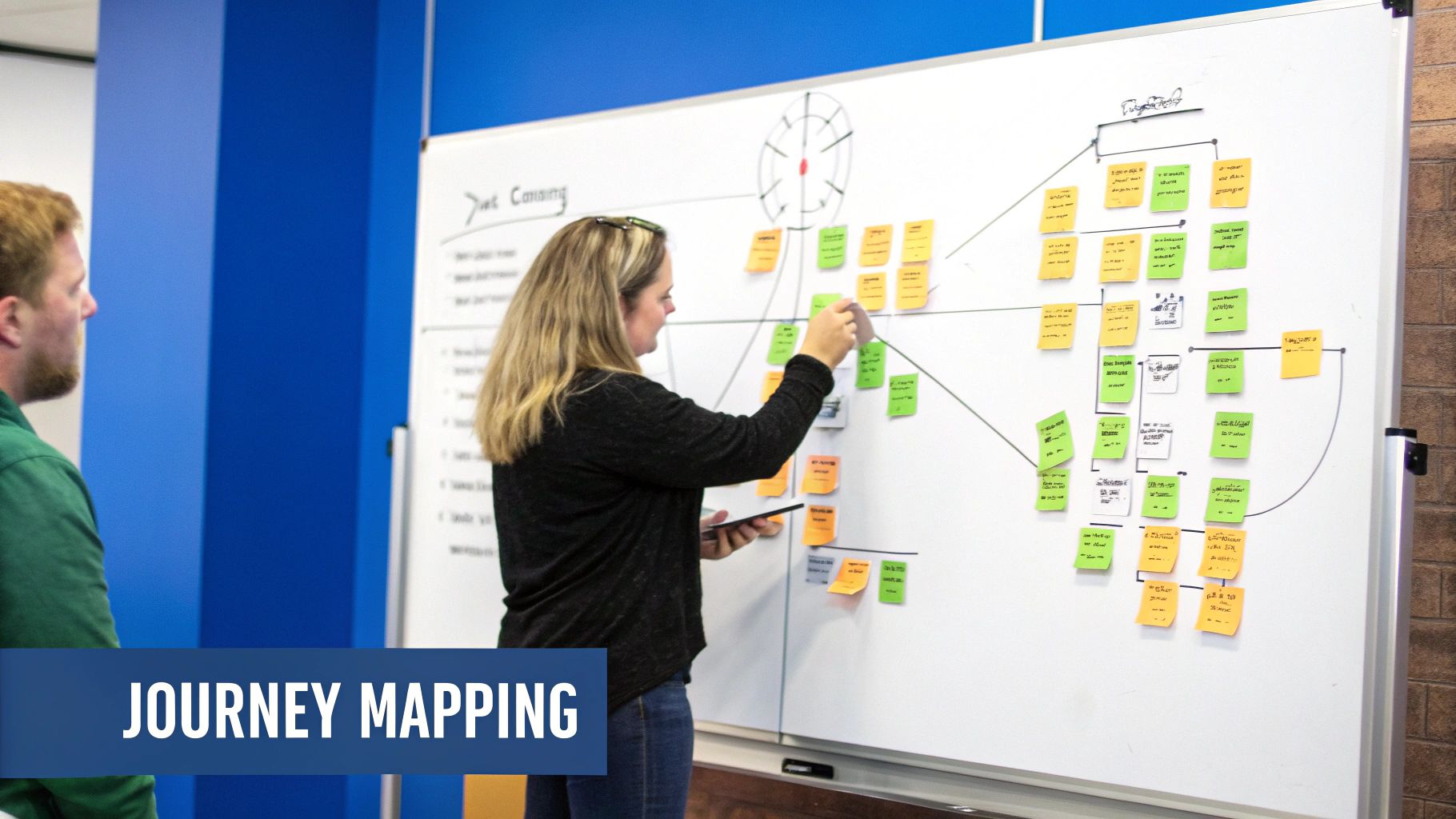
Examples of successful implementations include Disney’s MagicBand system, automating park experiences, Starbucks’ mobile app journey connecting rewards and ordering, and Tesla’s seamless customer journey from online configuration to delivery. Leveraging marketing automation strategies is key to streamlining these efforts. Platforms like Adobe Experience Cloud and Salesforce Customer 360 offer robust capabilities for mapping and automating customer journeys.
Implementing Effective Customer Journey Mapping
- Start with the current state: Before designing ideal workflows, map your existing customer journey. Identify pain points and areas for improvement.
- Collaborate across departments: Involve multiple teams (sales, marketing, customer service) in mapping exercises for a holistic view.
- Validate with customer feedback: Use surveys and interviews to ensure your journey map accurately reflects customer experiences.
- Gradual implementation: Roll out automation in stages rather than attempting a complete overhaul at once.
- Data-driven optimization: Regularly analyze journey performance data and update your map based on customer behavior and feedback.
Customer journey mapping and automation not only improves customer satisfaction but also optimizes marketing spend. By delivering the right message at the right time, you enhance engagement and drive conversions. This marketing automation strategy fosters loyalty and advocacy, turning customers into brand ambassadors.
5. Dynamic Content Personalization
Dynamic content personalization is a powerful marketing automation strategy that tailors content, offers, and messaging based on individual user characteristics, preferences, behaviors, and real-time context. This approach creates unique experiences for each user, enhancing engagement and conversion rates, without manual intervention. Instead of a one-size-fits-all approach, dynamic personalization delivers the most relevant content to the right person at the right time.
Think of Spotify’s personalized “Discover Weekly” playlists, Amazon’s unique product recommendations on its homepage, or LinkedIn’s tailored feed and job suggestions. These platforms utilize dynamic content personalization to provide individual user experiences, increasing engagement and platform stickiness. YouTube’s recommended video algorithm is another prime example of this strategy in action.
To effectively supercharge your marketing in 2025, consider platforms like Amazon Web Services Personalize, Adobe Target, Optimizely, and Salesforce Interaction Studio (formerly Evergage). These platforms offer robust dynamic personalization capabilities, allowing you to segment your audience and deliver tailored content based on a range of data points.
Implementing Effective Dynamic Content Personalization
- Start simple: Begin with basic personalization like name and location before implementing more complex algorithms.
- Data quality: Ensure data accuracy and cleanliness for precise and effective personalization. Inaccurate data leads to irrelevant content, hindering your efforts.
- Transparency: Be open about data usage to build trust with your audience. Clearly communicate your data collection and usage policies.
- Test and iterate: Continuously compare the performance of personalized content against generic content to measure the effectiveness of your strategy.
- Fallback content: Prepare default content for users with limited data profiles to ensure a positive experience for everyone.
Dynamic content personalization not only boosts engagement and conversions but also fosters stronger customer relationships. By demonstrating that you understand individual needs and preferences, you build trust and loyalty, ultimately driving business growth. This marketing automation strategy allows businesses to move beyond generic messaging and create meaningful connections with their audience, maximizing the impact of their marketing efforts.
6. Multi-Channel Marketing Orchestration
Multi-channel marketing orchestration is a sophisticated marketing automation strategy. It coordinates marketing messages across various channels. These include email, SMS, social media, push notifications, and even direct mail. This creates unified and personalized customer experiences. Instead of siloed channel campaigns, orchestration ensures consistent messaging while optimizing the channel mix for each individual.
Companies like Sephora, Starbucks, and Nike effectively use multi-channel orchestration. Sephora seamlessly connects email, app, and in-store experiences. Starbucks integrates its mobile app with email and in-store promotions. Nike executes omnichannel campaigns across social media, email, mobile, and retail stores. These brands demonstrate the power of delivering a consistent brand experience across various touchpoints.
Implementing Effective Multi-Channel Orchestration
- Establish clear brand guidelines: Ensure consistent messaging across all channels. This creates a unified brand identity and avoids confusing customers.
- Data-driven channel mix: Use customer data to determine the optimal channel mix for each individual. Personalize the customer journey by delivering messages through their preferred channels.
- Frequency caps: Implement frequency caps across all channels. This prevents over-saturation and maintains a positive customer experience. Avoid bombarding customers with excessive messages.
- Channel-specific content: Create content tailored to each channel while maintaining the core message. Optimize content format and length for each platform while preserving brand consistency.
- Monitor cross-channel attribution: Track how different channels contribute to conversions. Optimize budget allocation based on performance data.
Multi-channel marketing orchestration is particularly valuable for businesses with a diverse customer base and a presence across multiple channels. It improves customer engagement, enhances brand loyalty, and ultimately drives higher conversion rates. This powerful marketing automation strategy streamlines communication. It also ensures that every customer touchpoint contributes to a cohesive and personalized brand experience. Learn more about Multi-Channel Marketing Orchestration. This approach allows businesses to effectively engage customers throughout their journey, maximizing the impact of marketing efforts.
7. Predictive Analytics and AI-Driven Automation
Predictive analytics and AI-driven automation represent an advanced marketing automation strategy. This approach uses machine learning algorithms and predictive analytics to forecast customer behavior, identify opportunities, and automatically trigger appropriate marketing actions. It leverages historical data, such as website activity, purchase history, and email engagement, to make intelligent predictions about future customer actions. This allows businesses to anticipate needs and personalize interactions at scale.
Examples of successful implementations include Netflix’s content recommendation algorithm, Uber’s surge pricing based on demand prediction, and Amazon’s anticipatory shipping. These companies use predictive analytics to enhance customer experience and optimize operations. Spotify also leverages a churn prediction model to trigger targeted retention campaigns. This proactive approach allows businesses to address potential customer issues before they escalate.
Implementing Predictive Analytics and AI
- Start simple: Begin with basic predictive models before implementing complex AI-driven systems. Focus on specific use cases, such as predicting customer churn or identifying high-value leads.
- Data quality: Ensure data accuracy and completeness. Sufficient historical data is crucial for training effective predictive models.
- Model validation: Regularly validate and retrain your models to maintain their accuracy as customer behavior evolves. This ensures your predictions remain relevant and effective.
- Human expertise: Combine AI insights with human expertise to make informed decisions. AI provides data-driven predictions, while human input adds context and nuance.
- A/B testing: Test predicted outcomes against control groups to measure the effectiveness of your AI-driven automation. This allows for continuous improvement and optimization.
Predictive analytics empowers businesses to move beyond reactive marketing and adopt a proactive approach. By anticipating customer needs and automating personalized interactions, companies can improve customer engagement, increase conversion rates, and maximize marketing ROI. Learn more about Predictive Analytics and AI-Driven Automation. This powerful marketing automation strategy enables businesses to make data-driven decisions and deliver highly targeted campaigns, ultimately leading to improved business outcomes.
8. Account-Based Marketing (ABM) Automation
Account-Based Marketing (ABM) automation is a targeted marketing automation strategy that concentrates resources on specific high-value accounts instead of broader audiences. It personalizes outreach, content, and experiences for individual accounts or similar account groups, treating each as its own market. This approach fosters stronger relationships and higher conversion rates by delivering highly relevant and tailored interactions.
Companies like Salesforce, using Terminus’s ABM platform, have successfully targeted enterprise accounts with personalized campaigns. Adobe has created custom microsites for Fortune 500 prospects, and GE utilizes account-specific content hubs for key industrial clients. These examples highlight the effectiveness of ABM in engaging high-value prospects.
To effectively supercharge your marketing in 2025, consider leveraging proven marketing automation strategies to streamline ABM efforts. Platforms like Terminus, Demandbase, and 6sense provide robust ABM automation capabilities. They offer features like account identification, personalized messaging, and multi-channel campaign orchestration, allowing businesses to efficiently manage their ABM initiatives.
Implementing Effective ABM Automation
- Start small: Initially focus on a small group of high-value target accounts.
- Align sales and marketing: Ensure both teams agree on account selection criteria.
- Tailored content: Create account-specific content and messaging for maximum impact.
- Multi-channel approach: Use various channels like email, social media, and direct mail.
- Measure account engagement: Track account-level interactions, not just lead metrics.
ABM automation enhances the customer experience by delivering highly personalized content that resonates with individual account needs. This focused approach maximizes marketing ROI by prioritizing efforts on the most promising opportunities, making it a crucial marketing automation strategy for businesses seeking significant growth.
9. Social Media Marketing Automation
Social media marketing automation streamlines managing your social presence, encompassing content scheduling, audience engagement, social listening, and automated responses. This strategic approach maintains a consistent online presence while identifying and responding to valuable engagement and customer service opportunities. By automating routine tasks, businesses can free up time to focus on strategy and content creation, ultimately enhancing their social media marketing effectiveness.
To effectively amplify your reach and engagement in the digital landscape, consider implementing marketing automation strategies tailored to your specific social media channels. Leading brands like Wendy’s, Nike, and KLM demonstrate the power of automation. Wendy’s leverages Twitter automation to schedule witty posts aligned with their brand voice, while Nike automates Instagram for product launches and user-generated content campaigns. KLM uses Facebook Messenger automation to efficiently handle customer service inquiries.
Implementing Effective Social Media Automation
- Balance automation with human interaction: While automation is valuable, maintain a personal touch by engaging directly with your audience.
- Platform-specific content: Tailor your content to each platform instead of cross-posting identical messages. Consider the unique audience and format of each channel.
- Social listening: Set up alerts for brand mentions and relevant keywords to track conversations and identify opportunities for engagement.
- Strategic automation: Use automation primarily for scheduling, not for all customer interactions. Prioritize genuine engagement with your audience.
- Regular review and update: Continuously review and update your automated responses to ensure they remain relevant and effective.
Social media marketing automation empowers businesses to optimize their social media presence, boosting efficiency and engagement. By automating repetitive tasks, marketers can dedicate more time to crafting compelling content and fostering meaningful connections with their target audience. This targeted approach not only improves brand visibility but also enhances customer satisfaction, ultimately contributing to a stronger online presence and a more successful marketing automation strategy.
10. Customer Retention and Lifecycle Marketing Automation
Customer retention and lifecycle marketing automation is a comprehensive strategy focused on maintaining and growing relationships with existing customers. This approach uses targeted communications, loyalty programs, and experience optimization to nurture customer relationships and maximize lifetime value. By automating touchpoints throughout the entire customer lifecycle, businesses can proactively address customer needs and encourage repeat purchases. This automation strategy goes beyond simple transactional emails and delves into personalized engagement based on customer behavior and lifecycle stage.
Companies like Spotify, Amazon Prime, Dropbox, and Slack effectively use lifecycle marketing automation. Spotify’s ‘Wrapped’ campaign celebrates user engagement, while Amazon Prime automates renewal reminders highlighting member benefits. Dropbox uses usage-based data to trigger upgrade recommendations, and Slack implements feature adoption campaigns for existing users. These examples demonstrate the power of personalized and timely communication in boosting customer retention. To effectively supercharge your marketing in 2025, consider leveraging proven marketing automation strategies to streamline these efforts.
Implementing Effective Customer Retention Automation
- Map the customer lifecycle: Identify key stages in your customer journey, from initial purchase to advocacy.
- Create health scores: Develop customer health scores based on usage, engagement, and support interactions.
- Automate key moments: Trigger automated messages for milestones like birthdays, anniversaries, or purchase anniversaries.
- Graduated retention efforts: Implement tiered retention strategies based on churn risk and customer value.
- Personalize offers: Tailor retention offers and incentives based on individual customer preferences and purchase history.
Customer retention and lifecycle marketing automation are crucial for sustainable business growth. This marketing automation strategy focuses on maximizing the value of existing customers, leading to increased revenue and reduced customer acquisition costs. By proactively nurturing customer relationships, businesses can build loyalty, encourage repeat business, and create brand advocates. Learn more about customer lifecycle marketing and how to improve customer retention within your business. This proactive approach strengthens customer relationships and significantly contributes to long-term profitability.
Marketing Automation Strategies Comparison
| Strategy | Implementation Complexity 🔄 | Resource Requirements ⚡ | Expected Outcomes 📊 | Ideal Use Cases 💡 | Key Advantages ⭐ |
|---|---|---|---|---|---|
| Lead Scoring and Nurturing | High – needs ongoing refinement | Moderate to High – CRM integration needed | Improved sales efficiency and conversion | Prioritizing high-value leads in sales pipelines | Data-driven lead qualification and targeted messaging |
| Drip Email Campaigns | Moderate – pre-built sequences and triggers | Moderate – content creation & optimization | Consistent communication and lead nurturing | Nurturing prospects over time with timed messaging | Scalable automation with measurable ROI |
| Behavioral Triggered Campaigns | High – requires real-time tracking setup | High – complex infrastructure and data use | Higher engagement through timely outreach | Real-time response to user actions and behaviors | Highly relevant, personalized messaging |
| Customer Journey Mapping and Automation | Very High – extensive planning and cross-team effort | Very High – multi-system integration | Cohesive end-to-end customer experiences | Comprehensive lifecycle automation and personalization | Unified experiences and journey gap identification |
| Dynamic Content Personalization | High – advanced AI and data management | High – substantial data and technical needs | Increased engagement and conversion rates | Delivering individualized experiences at scale | Competitive differentiation via personalization |
| Multi-Channel Marketing Orchestration | Very High – integration across many channels | Very High – cross-platform coordination | Maximized reach and campaign effectiveness | Synchronizing omnichannel marketing communications | Consistent messaging and optimized channel use |
| Predictive Analytics and AI-Driven Automation | Very High – AI model building and validation | Very High – large data sets and expert input | Proactive marketing with improved performance | Forecasting behavior and automated decision-making | Advanced insights reducing manual errors |
| Account-Based Marketing (ABM) Automation | High – focused but resource-intensive | High – deep research and content personalization | Higher ROI through targeted account efforts | Marketing to high-value accounts | Strong sales-marketing alignment and personalized outreach |
| Social Media Marketing Automation | Moderate – tools for scheduling and monitoring | Moderate – tool subscriptions and content | Consistent engagement and brand monitoring | Managing multi-platform social presence | 24/7 monitoring with scalable publishing |
| Customer Retention and Lifecycle Marketing Automation | High – complex workflows and data tracking | High – lifecycle stage management and analytics | Increased lifetime value and churn reduction | Retaining and growing existing customer base | Proactive engagement and revenue automation |
The Future of Marketing is Automated
This curated collection of marketing automation strategies has explored a range of powerful techniques for enhancing customer engagement, lead qualification, and sales. From leveraging AI-driven chatbots and predictive analytics to orchestrating multi-channel campaigns and personalizing content, these strategies offer a pathway to streamlined efficiency and accelerated growth. The key takeaway is the importance of adapting these approaches to your specific business needs and customer profiles.
Key Takeaways and Actionable Next Steps
Mastering these marketing automation strategies is crucial in today’s competitive landscape. They enable businesses to:
- Scale marketing efforts: Reach a wider audience and personalize interactions without exponentially increasing resources.
- Improve customer experience: Deliver targeted messages and offers at the right time, enhancing customer satisfaction and loyalty.
- Boost conversion rates: Nurture leads effectively and move them seamlessly through the sales funnel, leading to increased conversions.
- Gain valuable data insights: Track campaign performance, analyze customer behavior, and refine strategies based on real-time data.
To capitalize on these benefits, start by prioritizing the strategies most relevant to your current challenges and objectives. For example, if lead nurturing is a primary concern, focus on implementing lead scoring and drip email campaigns. If improving customer retention is key, concentrate on lifecycle marketing automation and personalized customer journey mapping.
Embracing AI-Powered Automation for Long-Term Success
The future of marketing lies in the strategic integration of AI-powered solutions. By automating repetitive tasks, marketers can free up time and resources to focus on strategic initiatives, creative content development, and building meaningful customer relationships. Implementing these strategies empowers businesses to create hyper-personalized experiences, anticipate customer needs, and ultimately drive sustainable growth.
As we move forward, the ability to leverage AI and automation will become increasingly vital for success. The integration of intelligent tools across various marketing channels will enable businesses to optimize every touchpoint and create seamless, engaging customer journeys. This translates to improved efficiency, increased ROI, and sustained growth. Embrace these innovative marketing automation strategies and position your business for success in the dynamic digital landscape.
Ready to streamline your marketing automation and create exceptional customer experiences? Explore Social Intents, a powerful platform that integrates seamlessly with your existing tools to enhance customer support and marketing automation efforts. Visit Social Intents to discover how it can revolutionize your customer interactions and drive business growth.
